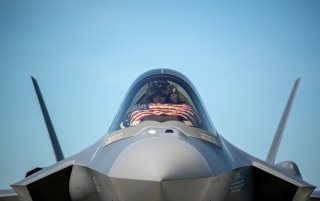Why the F-35 Stealth Fighter Isn't Going Away
If the dollars are there, then most pilots and Air Force weapons developers are likely to wish for the full fleet of F-35 jets and new sixth-generation aircraft.
“Every hinge, every bolt, every fastener and every panel is closed back up when we are done with work on the airplane, so every time we take off we are in that stealth, non-detectable configuration, “We hide the radar, antenna and fuel—they are all protrusions which reduce hope that you would ever reduce vulnerability,” Flynn said.
Interestingly, I also spoke with a combat-tested F-35 pilot in 2015, former Col. Todd Canterbury. Col. Canterbury is a former F-35 pilot and instructor, is another pilot with decades flying fourth-generation platforms. He said the F-35 fighter brings a wide range of new technologies including advanced sensors, radar, weapons for attack and next-generation computers.
Although he serves now as Chief, Operations Division of the F-35 Integration Office at the Pentagon, Canterbury previously trained F-35 pilots at Eglin Air Force Base, Fla. Canterbury is uniquely positioned to know the F-35’s margins of difference because he has spent thousands of hours flying legacy aircraft such as the service’s F-15 and F-16 fighters.
“The F-35 is a dream to fly. It is the easiest airplane to fly. I can now focus on employment and winning the battle at hand as opposed to looking at disparate information and trying to handle the airplane,” Canterbury told The National Interest in 2015.
Canterbury talked about the F-35s “sensor fusion” The EOTs system is engineered to work in tandem with a technology called the Distributed Aperture System, or DAS, a collection of six cameras strategically mounted around the aircraft to give the pilot a 360-degree view.
“I can turn my head and look left or right. There is an aiming cross on my helmet, an aiming symbology that tells me how to get there. The system will swivel over to the point on the ground I have designated,” Canterbury described. “I can look through the airplane and see the ground below me. I can look directly below me without having to obscure my vision,” Canterbury said.
The DAS includes precision tracking, fire control capabilities and the ability to warn the pilot of an approaching threat or missile, developers explain.
The F-35 is also engineered with an Active Electronically Scanned Array Radar which is able to track a host of electromagnetic signals, including returns from Synthetic Aperture Radar, or SAR. This paints a picture of the contours of the ground or surrounding terrain and, along with Ground Moving Target Indicator, or GMTI, locates something on the move on the ground and airborne objects or threats.
What does all this mean? In short, if the dollars are there, most pilots and Air Force weapons developers are likely to wish for the full fleet of F-35s and new sixth-generation aircraft, of course. Also, to the extent that allied interoperability and interest offers a window of insight into the jet’s value in a great-power war threat atmosphere, there do appear to be a lot of indications. Denmark and Poland are receiving their first F-35s, Japan is spending billions to generate its own F-35 fleet and new customers such as Israel and others have emerged alongside the original partners.
Kris Osborn is the defense editor for the National Interest. Osborn previously served at the Pentagon as a Highly Qualified Expert with the Office of the Assistant Secretary of the Army—Acquisition, Logistics & Technology. Osborn has also worked as an anchor and on-air military specialist at national TV networks. He has appeared as a guest military expert on Fox News, MSNBC, The Military Channel, and The History Channel. He also has a Masters Degree in Comparative Literature from Columbia University.
Image: Reuters.

